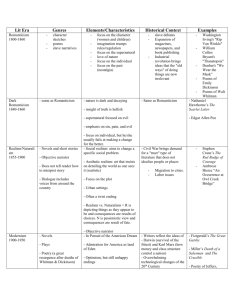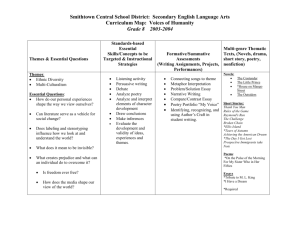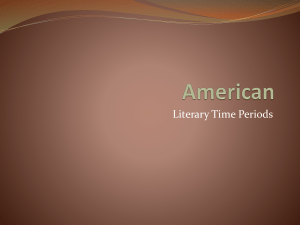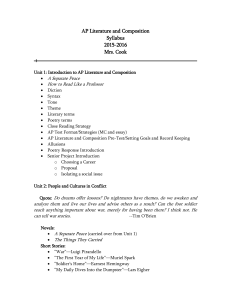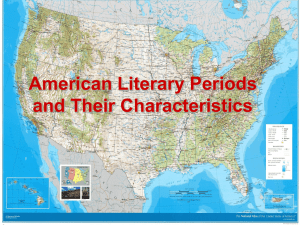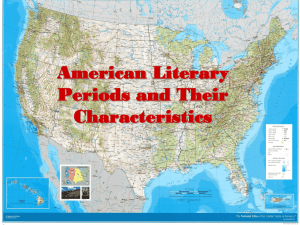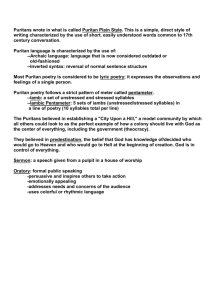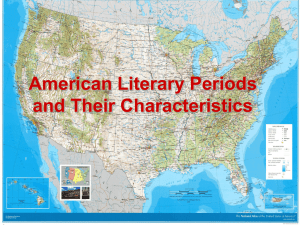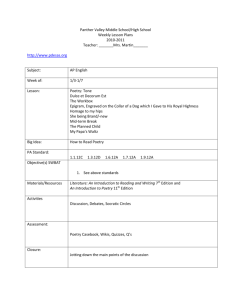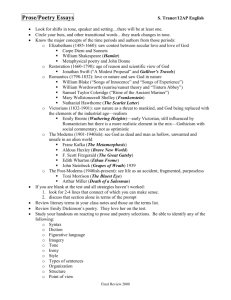Literary Periods & Characteristics: A Quick Guide
advertisement
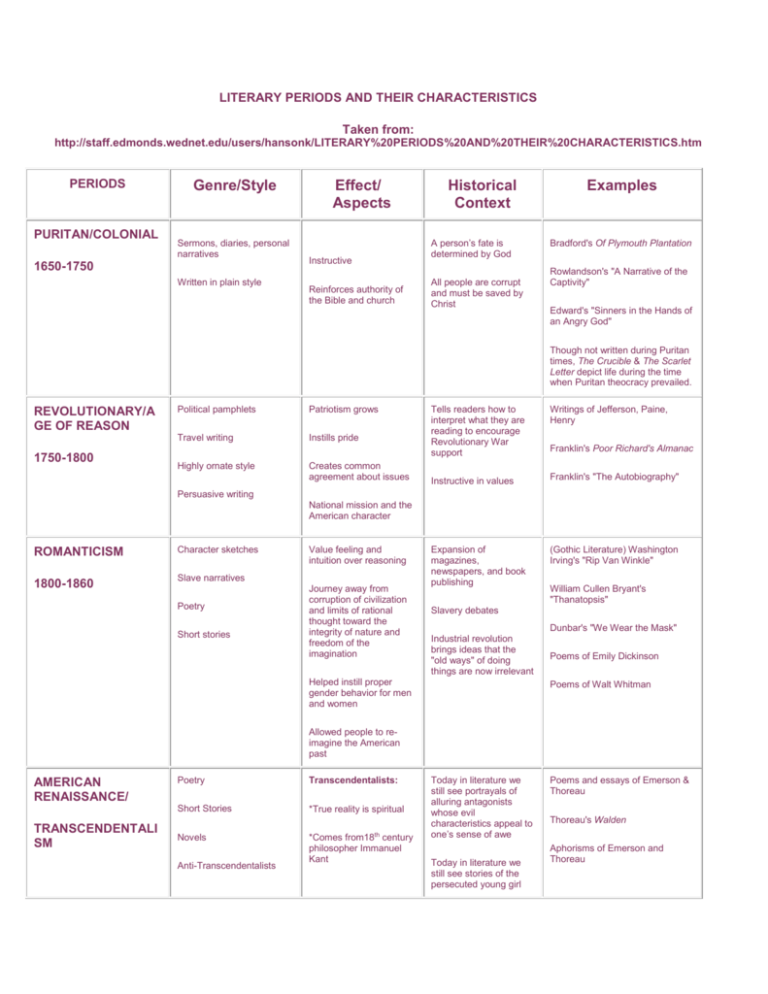
LITERARY PERIODS AND THEIR CHARACTERISTICS Taken from: http://staff.edmonds.wednet.edu/users/hansonk/LITERARY%20PERIODS%20AND%20THEIR%20CHARACTERISTICS.htm PERIODS PURITAN/COLONIAL Genre/Style Sermons, diaries, personal narratives 1650-1750 Written in plain style Effect/ Aspects Instructive Reinforces authority of the Bible and church Historical Context A person’s fate is determined by God All people are corrupt and must be saved by Christ Examples Bradford's Of Plymouth Plantation Rowlandson's "A Narrative of the Captivity" Edward's "Sinners in the Hands of an Angry God" Though not written during Puritan times, The Crucible & The Scarlet Letter depict life during the time when Puritan theocracy prevailed. REVOLUTIONARY/A GE OF REASON 1750-1800 Political pamphlets Patriotism grows Travel writing Instills pride Highly ornate style Creates common agreement about issues Tells readers how to interpret what they are reading to encourage Revolutionary War support Writings of Jefferson, Paine, Henry Instructive in values Franklin's "The Autobiography" Expansion of magazines, newspapers, and book publishing (Gothic Literature) Washington Irving's "Rip Van Winkle" Franklin's Poor Richard's Almanac Persuasive writing National mission and the American character ROMANTICISM Character sketches 1800-1860 Slave narratives Poetry Short stories Value feeling and intuition over reasoning Journey away from corruption of civilization and limits of rational thought toward the integrity of nature and freedom of the imagination William Cullen Bryant's "Thanatopsis" Slavery debates Dunbar's "We Wear the Mask" Industrial revolution brings ideas that the "old ways" of doing things are now irrelevant Helped instill proper gender behavior for men and women Poems of Emily Dickinson Poems of Walt Whitman Allowed people to reimagine the American past AMERICAN RENAISSANCE/ TRANSCENDENTALI SM Poetry Transcendentalists: Short Stories *True reality is spiritual Novels *Comes from18th century philosopher Immanuel Kant Anti-Transcendentalists Today in literature we still see portrayals of alluring antagonists whose evil characteristics appeal to one’s sense of awe Today in literature we still see stories of the persecuted young girl Poems and essays of Emerson & Thoreau Thoreau's Walden Aphorisms of Emerson and Thoreau 1840-1860 (Note overlap in time period with Romanticism -- some consider the antitranscendentalists to be the "dark" romantics or gothic) *Hold readers’ attention through dread of a series of terrible possibilities *Feature landscapes of dark forests, extreme vegetation, concealed ruins with horrific rooms, depressed characters * Idealists * Self-reliance & individualism * Emerson & Thoreau AntiTranscendentalists: forced apart from her true love Today in literature we still read of people seeking the true beauty in life and in nature … a belief in true love and contentment Nathaniel Hawthorne's The Scarlet Letter Poe's "The Masque of the Red Death" and "The Black Cat" Herman Melville’s Moby Dick * Used symbolism to great effect *Sin, pain, & evil exist * Irving, Poe, Hawthorne, & Melville REALISM Novels and short stories 1855-1900 Objective narrator (Period of Civil War and Postwar period) Does not tell reader how to interpret story Social realism: aims to change a specific social problem Aesthetic realism: art that insists on detailing the world as one sees it Civil War brings demand for a "truer" type of literature that does not idealize people or places Novels 1900-1950 Plays Poetry (a great resurgence after deaths of Whitman & Dickinson) Highly experimental as writers seek a unique style The Narrative of the Life of Frederick Douglass The Adventures of Huckleberry Finn (some say 1st modern novel) Dialogue includes voices from around the country THE MODERNS Writings of Twain, Bierce, Crane Regional works like: The Awakening. Ethan Frome, and My Antonia (some say modern) In Pursuit of the American Dream-*Admiration for America as land of Eden *Optimism *Importance of the Individual Writers reflect the ideas of Darwin (survival of the fittest) and Karl Marx (how money and class structure control a nation) Fitzgerald's The Great Gatsby Overwhelming technological changes of the 20th Century Rand's Anthem Rise of the youth culture Use of interior monologue & stream of consciousness WWI and WWII Harlem Renaissance Poetry of Jeffers, Williams, Cummings, Frost, Eliot, Sandburg, Pound, Robinson, Stevens Short stories and novels of Steinbeck, Hemingway, Thurber, Welty, and Faulkner Hansberry's A Raisin in the Sun & Wright's Native Son (an outgrowth of Harlem Renaissance-- see below) Miller's The Death of a Salesman (some consider Postmodern) HARLEM RENAISSANCE (Parallel to modernism) 1920s Allusions to AfricanAmerican spirituals Gave birth to "gospel music" Uses structure of blues songs in poetry (repetition) Blues and jazz transmitted across American via radio and phonographs Superficial stereotypes revealed to be complex characters Mass African-American migration to Northern urban centers Essays & Poetry of W.E.B. DuBois Poetry of McKay, Toomer, Cullen African-Americans have more access to media and publishing outlets after they move north Poetry, short stories and novels of Hurston and Hughes Their Eyes Were Watching God POSTMODERNISM Mixing of fantasy with nonfiction; blurs lines of reality for reader Erodes distinctions between classes of people No heroes Insists that values are not permanent but only "local" or "historical" 1950 to present Note: Many critics extend this to present and merge with Contemporary -see below) Concern with individual in isolation Post-World War II prosperity Mailer's The Naked and the Dead and The Executioner's Song Media culture interprets values Feminist & Social Issue poets: Plath, Rich, Sexton, Levertov, Baraka, Cleaver, Morrison, Walker & Giovanni Miller's The Death of a Salesman & The Crucible (some consider Modern) Social issues as writers align with feminist & ethnic groups Lawrence & Lee's Inherit the Wind Usually humorless Capote's In Cold Blood Narratives Stories & novels of Vonnegut Metafiction Salinger's Catcher in the Rye Present tense Beat Poets: Kerouac, Burroughs, & Ginsberg Magic realism Kesey's One Flew Over the Cuckoo's Nest CONTEMPORARY 1970s-Present (Continuation of postmodernism) Narratives: both fiction and nonfiction Too soon to tell People beginning a new century and a new millennium Anti-heroes Concern with connections between people Media culture interprets values Poetry of Dove, Cisneros, Soto, Alexie Writings of Angelou, Baldwin, Allende, Tan, Kingsolver, Kingston, Grisham, Crichton, Clancy Emotion-provoking Walker's The Color Purple & Haley's Roots Humorous irony Butler's Kindred Storytelling emphasized Guest's Ordinary People Autobiographical essays Card's Ender's Game O'Brien The Things They Carried Frazier's Cold Mountain
